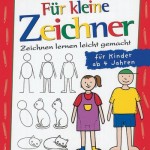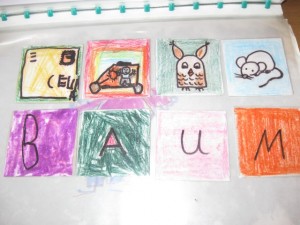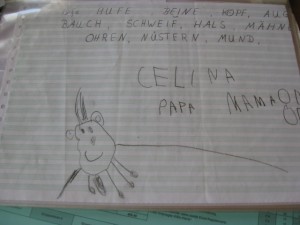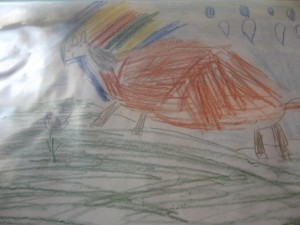by Silvia Hempler
One of the girls in my group (Linda, 5;0) has come to my attention.
She disposes of good verbal expression and keen perception. She talks a lot and enjoys doing so, tries to direct the other children’s playing situations, such as role-play, and has great difficulties adapting herself. She sticks out, due to her relatively poor social behaviour.
Her mother reports that Linda could distinguish left from right at an age of 2. Her preferred literature at that time were the reference and text books of her father, who was then undergoing an RN-training. The other kids in her nursery group had to experience quite a few fisticuffs, because they wouldn’t play doctor the way Linda had told them to.
Linda, a bright girl that has just turned 5, will not only learn to draw figuratively; she will also make a range of valuable social experiences, thus bringing her a step closer to her desire of being more popular amongst the other children.
After working with Joelle Huser’s observational chart, I would like to highlight the following aspects:
Linda has command of a large vocabulary. She reports, for example:
„My mum wants to help other women give birth to their babies. She teaches them about how their children lie in their tummies and what to do, so they are born healthy.“
At the moment Linda is learning Polish. She often asks me to tell her special words, so that she can translate them, or she lists words she already knows and translates them.
She doesn’t make any grammatical mistakes and expresses herself well.
She is also rather quick-witted, never at loss for an answer, both in positive and negative situations.
She often comes up with logical explanations, giving grown-ups the impression that she feels superior to them, being seemingly unfazed by consequences of her bad behaviour. She will say something like:
„… and what’s that supposed to be good for?“
I’ve also noticed a particular mathematical-logical intelligence in Linda. For example, in a conversation with me about the size of craters on the moon, she asked me spontaneously:
„Are craters as wide as a thousand skyscrapers?“
She is able to add in steps of 5 and will only accept to do puzzles with 100 pieces.
Concerning her special interests and activities she spends most of her time with:
Firstly, there are her parents‘ professions: RN and midwife. She seems to be constantly learning from her parents‘ experiences.
She is also very interested in horses. She knows the entire terminology around horses, riding and care-taking of these animals.
She also ponders matters concerning our universe and space.
Once I showed her why the moon isn’t always full with the help of a book, she immediately understood, looked at me and said:
„Is that all?“
At the moment, she is collecting information explaining the extinction of the dinosaurs.
Next to her special areas of interest and exceptional abilities, I’ve noticed how Linda lacks empathy and attention for the interests of her peers in age.
Example situation:
Her friends are busy doing craft-work. Linda will continuously interrupt them, until they finally give in and join Linda in that role-play in the doll-corner, she wants to play.
She may even tend to support her goal by scribbling on her friends‘ art-work, just so they will give up their current activity.
Please note the article: Girls Having Their Way (in German)
Linda shows no inclination of adapting to a (social) situation or holding herself back. Whenever she doesn’t get what she wants, right then, she will turn aggressive and start hitting the other children.
Example situation:
A child says: „I don’t want to hear that song. We want to dance.“
The child gets a stuffed toy dog beaten around its head.
Linda wants to be the leader of the group. She always has ideas and knows how to organize well. Yet, she lacks consideration and a collaborative mindset, and uses her (leading) position for her own interests.
She has a great sense of justice, but here also, her own interests will always stand at the centre of her attention.
She will say „I’m sorry!“ to any form of criticism.
This is her method of trying to avoid any further arguments on the matter. She’ll turn red in the face and her eyes will well up with tears, and the normally talkative child will only be able to reply with „yes“ and „no“. Insecurity is written all over her face. It can be quite difficult to build her up again, then. Often, she’ll turn very quiet for some time, or she’ll say what the adult wants to hear, being extremely friendly.
„Can I clear the table?“
(She hates clearing the table.)
The team again and again has doubts as to Linda’s higher intelligence, because she tends to hide her abilities very well.
Also note the article: Concealing Abilities and Interests.
Based on all my observations, I am nonetheless convinced, that Linda has special abilities, which have to be supported and stimulated during her time in kindergarten.
Unfortunately, my own professional abilities – just after the 1st seminar-phase (IHVO-Certificate Course) – seem not to suffice in this extremely challenging situation.
Her weak social interaction abilities seem to preoccupy her so much in group situations, that she doesn’t find time for other activities. She seems to be trying out different strategies, without coming to the intended result, for which she always sets rather high goals. But these are all only assumptions.
We may also not be offering her enough inspiration, in order for her to reach a certain level of contentedness.
After the 2nd seminar-phase, I decided to offer Linda a drawing course, in order to meet her interests, and to support her social integration into a small project group. She was supposed to have an opportunity to practise, improve and develop her behaviour towards the other children, and simultaneously acquire a new skill.
My ideas are:
– the drawing-course,
– exhibiting the children’s art-work inside the kindergarten,
– constructing a game,
– visiting an arts exhibition.
We used the book „Für kleine Zeichner“ (For young artists).
Reasons for planning this project
By means of focused observation, and by watching her in every-day situations, I have noticed, that Linda evaluates her abilities and deficits by checking them with the adults.
Her abilities in figurative drawing, for example, were poor, leaving her quite frustrated, but she would keep on saying:
„I did that well, didn’t I?“
Since she was using one typical tone-of-voice of hers when she said that, I decided to offer her help and constructive criticism instead of offering praise. I could immediately sense her positive reaction and gratitude. She let me help her and stayed by my side for the rest of the day, continuously asking me questions.
So, that was when and why I decided to offer a drawing course, in order to deal with two matters at once. Since Linda, as mentioned before, also lacks social interaction abilities, often comparing herself with the other bright girl in the group, Sandra, and showing hardly any interest in other playfellows, I picked a wide variety of characters as participants of this project.
The group is made up of
– a Turkish boy, who just simply wants to learn and be productive,
– a girl of average potential with little self-confidence,
– a gifted girl, who has serious problems with her motor skills and her emotional stability,
– two boys of average potential, yet highly motivated and always keen on new activities,
– a talented Turkish girl with poor language skills, who can draw very well and is otherwise extraordinarily developed,
– Sandra and
– Linda.
Luckily, I managed to motivate all the children I had chosen to take part in the project. Partially because they were interested in drawing, partially, because the children knew that I myself enjoyed drawing. They liked most of my drawings, which appeared to make me expert enough, in their opinions, to instruct a drawing course.
The constellation of the group appeared especially favourable to me, because it combined a broad collection of very particular character traits, and I was hoping for great social learning possibilities for all participating children, especially for Linda. I wanted her to experience, that the others had great abilities as well, and that she would reflect her old behaviour mode (If the other children don’t do as I want, I’ll hit them) and find new approaches.
Her self-confidence (I’m allowed to make mistakes) was to be strengthened. She was to be introduced to new fields of interest and supported in this.
Since I was in charge of monitoring the group without interruptions, I was able to work with reasonable impact and actively assist in difficult situations.
We began by drawing a person
The book mentioned above helped us a lot. Its clear shapes and simple line drawings let the children soon experience success with their artwork.
At first, we drew the simpler person, shaped a bit like a matchstick man. In the next attempt, we added a neck and a face, then a shirt and some trousers, and finally hands and shoes.
We spent about two weeks dealing with the human body and varying details.
During the entire period, Linda felt visibly comfortable within this group constellation. She watched very closely and attentively, and seemed to have understood that other children can be scared as well, and also, that they have weaknesses and strengths, just like she does.
This realisation process did not go about without conflict, but Linda learned that her drawings were not worth any less, because we didn’t put the last drawings in the folder, where we usually put them, but actually hung them up in the hallway of the kindergarten.
For this occasion, Linda and I designed a poster to direct the parents‘ attention to the group’s artwork, which it did, and due respect was paid along with plenty of praise for all of the children.
During the drawing course, the children realized, that writing is probably just as important or useful a skill as is figurative drawing. Writing, they realized, was also a form of communication, with which they could earn praise and gain attention.
Their own names on the drawings thus gained importance and, besides drawing, little samples of writing were generated.
During this time I discovered a game at a trade-fair, which combined both skills: drawing and writing.
Game Instructions:
There are cards you lay out, small symbol-cards, as well as letter-cards.
Each laying-card shows a picture resembling a word, for instance, a ball.
Each symbol-card shows a (small) picture resembling the first letter, for instance a bear stands for B, an ant stands for A, etc.
First you turn over a laying card, for example the ball-card. Then you try to lay out the word with the symbol-cards, and finally you match the correct letters underneath, so you have written the word BALL.
You can play different variants of the game as well.
Possible versions:
– Find other words (than those on the playing cards) and try laying them in letters,
– Use only symbol-cards or only letters,
– write out the words (with a pencil),
– make sentences out of words.
I introduced this game to the children and asked them to construct a game like it themselves. They were motivated by the fact that the drawings had to be realistic enough for most people to recognize, or else the letters couldn’t be matched.
So, this is how we went about it
We would think up a word and sketch the matching letter as well as a drawing for it. Each child had a task in the project, either making a drawing or writing the matching letter on a little card. Afterwards, the tasks were switched – those who had first drawn, would then write and vice versa.
Finally, each child had to create a bigger card, combining the drawing and the letter. During this phase of the project, we would turn to using the drawing-instructions-book, pictures and special books with lots of images as well as a table of the letters of the alphabet as aids.
Results
For me, the most important result of the project was, that it enabled an all inclusive learning process. Each child of the group experienced a form of success.
During the entire project, I never had the impression of asking too much or too little of them.
Linda’s progress with drawing a horse: Phase 1-3
Linda’s results:
-
- Linda has learned to show her abilities. Especially referring to the horse-drawings. She helped the other children find words and let me help her design a poster together with her, on which she wrote all by herself.
The other children saw that Linda could read, and accepted it as something completely normal, so that Linda herself could also accept that she had this ability.
- Linda has learned to show her abilities. Especially referring to the horse-drawings. She helped the other children find words and let me help her design a poster together with her, on which she wrote all by herself.
-
- The pictures and the books with images offered interesting topics, which Linda could work on as well (dinosaurs, insects).
- She immediately understood and used the first-grade alphabet table.
- Linda also understood that she couldn’t always force her opinion upon other children. Yet, understanding doesn’t imply being able to put this lesson into practice. She is still working on it and every now and then she actually succeeds in maintaining her self-control.
I have had many conversations with her and given her examples from her own experiences and situations she would judge as negative. The teamwork sessions during the project did the rest, after all, Linda does observe closely. - Linda has also learned to let Sandra do her own thing. Because of the alternating tasks, both girls couldn’t always work together. During the project, I was able to have conversations with both girls on the topic of friendship, realizing they had quite different views on it. Linda has understood that Sandra needs more space and freedom and will now sometimes even let her do things alone (e.g. have breakfast).
Sandra is a very versatile, multi-talented girl, who is very popular, due to her extremely good social behaviour. Linda wants to be loved as well, and being able to accept herself just the way she is, remains a great challenge for her and it will require a lot of support.
She is on her way now, finally. But her self-esteem is still quite low. She needs time in order to cope with her year-long experiences (I’m different and people don’t like me like that), and re-evaluate, re-arrange and classify them anew.
We should pick up where we left off in our last parent talk, which we had after the first seminar-phase. With them I would like to figure out what Linda’s needs are, and find out how she can realise her own plans and dreams.
Topics for the talk could be:
– What does Linda really want and need?
– What are the things she does only to get attention and praise?
– What could our kindergarten offer her, in order to support her, to enable her to use her skills, so that she gets the recognition she deserves?
– Which tasks and chores can she be in charge of at home (You are important)?
Last, but not least:
The children are still very interested in learning how to draw. They frequently grab and use the aforementioned material in their free-activity time.
At our last meeting of the drawing course, we talked about visiting an arts museum in Wuppertal (North-Rhine Westphalia) in order to study different techniques and colours. We went there and took part in a tour for children.
A local artist from Remscheid, Wolfgang Petermann, invited us to his craft-shop and showed us his etchings – and since he was crafting on the root of a tree at the time, we decided to try it out ourselves at the kindergarten.
Linda continues to need support building up her self-esteem. I have noticed that I get through to her best, by directly confronting her with a matter, finding words for her feelings and going into conversations with her.
Linda will need further opportunities to work in small groups, in order to practise her social skills and also to learn to control her reactions.
We will also make a conscious effort to include her special abilities into our daily schedule, so that she gets more positive feedback.
Date of publication in German: May, 2011
Copyright © Hanna Vock, siehe Impressum
Translation: Sonia Wagner / Arno Zucknick






